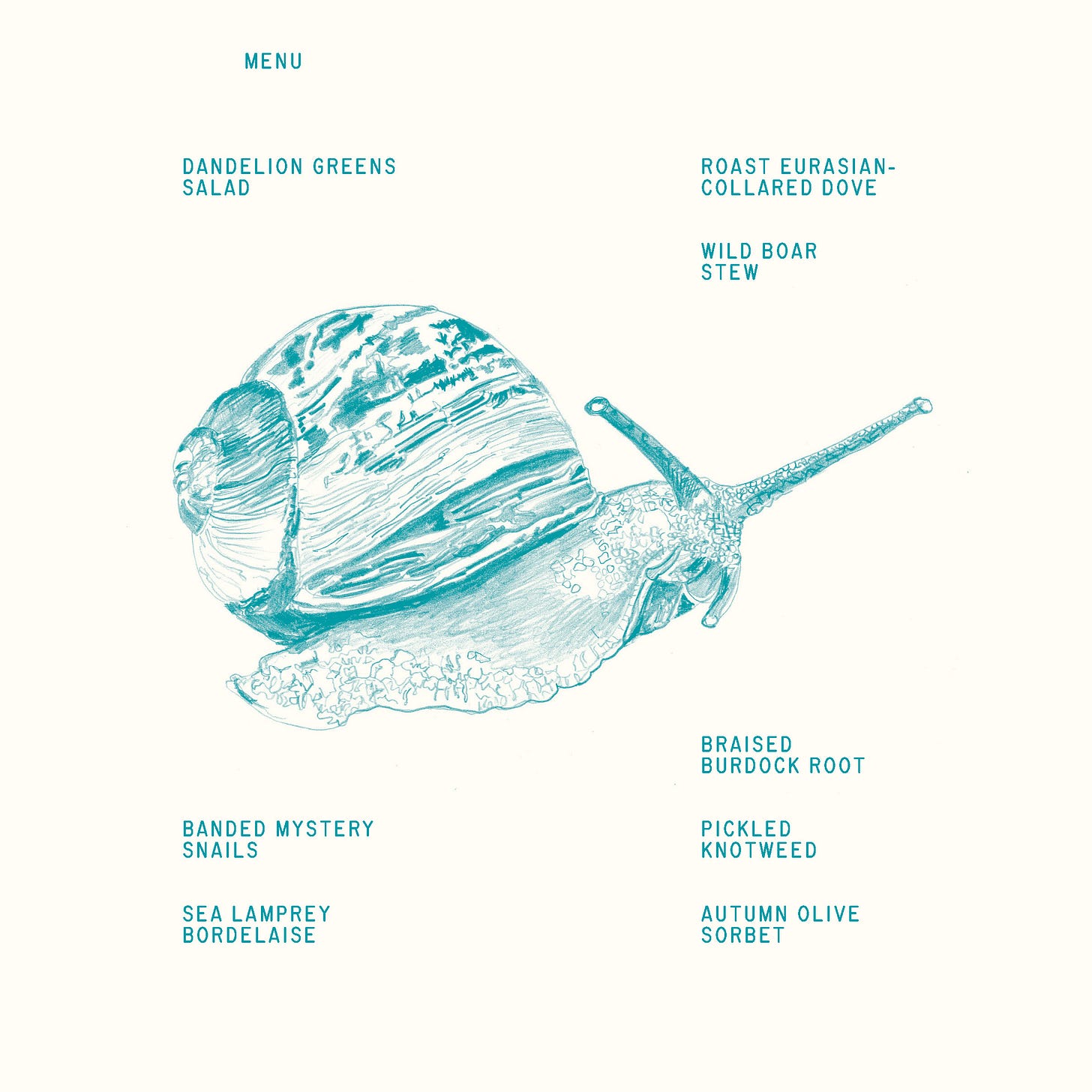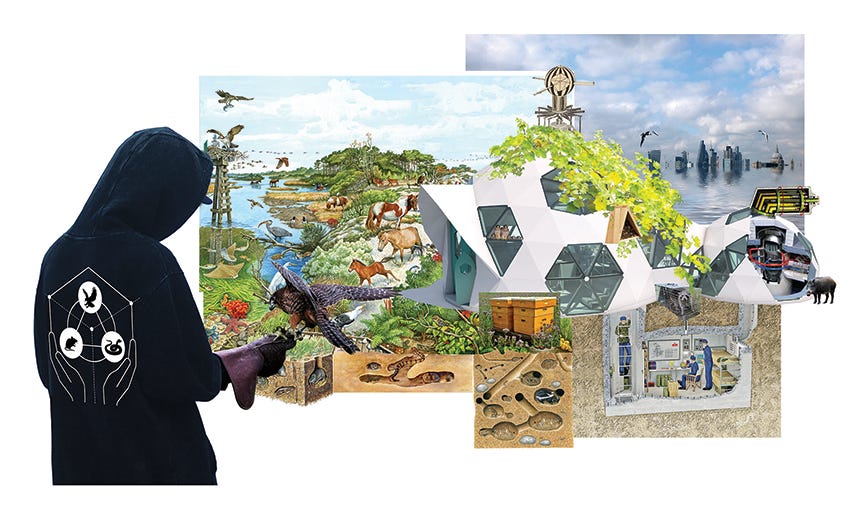In September 2022 we became members of the NEW INC New Museum incubator. This has led to a number of different mentor and business development experiences including working with dedicated mentor Marina Zurkow and being part of a group of incredible artists from our Creative Science cohort. This has provided an opportunity to expand our network, meet new creative thinkers and get input and insight along the way about our new project entitled Multispecies Inc.
Multispecies Inc. is a transdisciplinary art project that uses the output of a fictional organization to examine and critique the tension between idealized notions of multispecies living and our unwillingness to relinquish control. This multi-part ongoing research project examines and critiques our complex relationship with “nature” through the products of a fictional organization creating tools for multispecies living.
We envisage Multispecies Inc. as a global network of ecological stewards, grown from a grassroots movement that uses advanced digital sensing and AI technology to halt species extinctions and pursue equilibrium.
Decentering the human by fostering multispecies cohabitation, each communal outpost manages a biome, gathering data on every species, monitoring behavior and intervening to adjust for scarcity or overabundance.
Through this work a new typology of object emerges - the kin-gatherer. These tools for extreme empathy go beyond data-collection, providing visceral feedback on the “umwelt”* of other species. In doing so they generate new epistemologies - new ways of knowing - of making-kin with the non-human.
Manifested thus far through a book of short stories and illustrations and a public sculpture for Pier 17 in Manhattan, Multispecies Inc. is a framework for examining and critiquing interactions, exchanges, and syntheses between human and non-human living beings.
Using this fictional world as a catalyst for real-world paradigm shifts, this project will develop, build and share a collection of kin-gathering objects, each with the purpose of helping us make-kin with a particular species.
Acting as de facto members of the organization, we intend to set up residential outposts of Multispecies Inc. in which we will research each biome and develop designs for kin-gathering objects specific to a selected local species. These objects will be prototyped and displayed in Multispecies Inc. exhibitions in the US and abroad.




In the current ecological crisis there is a new focus upon decentering the human in relation to non-human species. “Entangled relationships” replace hierarchical ones, yet these theories largely ignore the physical realities of multispecies cohabitation, especially in the domestic realm. The project takes a radical and subversive approach by manifesting an apparently utopian vision in order to engage audiences in debate about our future actions. While the “fictional business-as-artwork” approach is not unique, we believe the combination of subject matter, satirical methods, collaborators and expertise is.
One of our early experiments for this ongoing climate fiction was a 28 page illustrated booklet produced for NEW INC’s Microbial Chorale dinner event presented at the Ace Hotel Brooklyn.
The stories were presented in a limited edition booklet, designed in collaboration with Michael Savona. Each cotton rag paper cover was hand-made at our studio. The cover is hand-cast into a mold taken from the surface of an ash tree killed by the emerald ash borer beetle. The indentations in the cover are the channels created by the larvae, which disrupt tree’s ability to carry nutrients.
The booklet features six short stories describing a future landscape where humans attempt to make kin with other species through the use of various devices and technical apparatus.

In each narrative prose piece we imagined different aspects of how this network of ecological stewards, would operate day-to-day.
The series of stories begins with A Letter Home - a letter written by a member of Multispecies Inc. to a friend detailing aspects of her daily life.
Phenology Diary is a description of one of the outposts from a resident point of view
Menu imagines the Multispecies Inc. members as invasivores - people who only eat invasive species.
System Memorandum reveals that a central computer - a powerful AI referred to only as The System - acts as Multispecies Inc’s third-party ally, consuming data inputted by members and gathered by a vast array of sensors.
The Kin-Gatherer - read at the Michrobial Chorale dinner by artist and performer Taja Cheek, describes a visceral encounter that a member of Multispecies Inc. has with a tree, a euphoric experience in which technology provides sensorial enhancement, enabling radical empathy.
Human as Houseplant hints that The System becomes aware of the humans as an invasive species that also nees to be managed and their numbers reduced.
*umweldt - the world as it is experienced by a particular organism.

Contents
A Message Home
System Memorandum
Phenology Diary
The Kin-Gatherer
Menu
Human As Houseplant
1. A Message Home
Hi Alma,
I’m sorry I’m just now writing you. It’s been non-stop activity since I arrived - and oh so cold! The wind blows constantly off the lake, chilling us to the bone. But when I get a break now and then the peace is wonderful.
The Inc. hasn't been here long - maybe 15 months. So it’s still a work in progress. The System is running smoothly and we’re at ECON 5 already, meaning only 1 in 1000 species are considered scarce or significantly overabundant. Which is a relief, honestly, because when Rick talked me into this, he didn’t say anything about the “balancing” I might have to do. I guess it’s necessary, but to me it feels counterintuitive. I came here to save species, not kill them. But you know what they say, "the System knows best."
And it does seem to work, actually. The piping plovers bounced back after we balanced the number of merlins that were targeting them. And it showed us that the bald eagles were disturbing cormorants and making their eggs vulnerable to scavengers. We didn’t have to balance the eagles - the national bird! Can you imagine? Thank heavens the sonic baffle we put up deterred them.
Even though we are in equilibrium on our patch, there remain some long-term projects which won’t be complete until long after I’m in my box, pushing up daisies. For instance, white pines used to dominate this area before they were clear-cut in the nineteenth century, and though we’re re-planting now, it’s going to take decades to repopulate.
It’s not all fresh air and green fingers, either. There’s plenty of weird stuff to be done here and our team draws lots for the nasty jobs. I had to collect a bunch of snails the other day from the lake shore after thousands had washed up dead. Ugh! The stench! I can still smell it - it’s permanently penetrated my nostrils.
When I’m stuck doing jobs like that, I laugh to myself that people could possibly think we’re a cult. You’d have to be selling a pretty enticing form of salvation to deal with the stuff we’re asked to do. We’re definitely more Geek Squad than Heaven’s Gate, believe me. Everyone’s got a PhD in xyz, except for li’l ol’ me. That’s not quite true, actually, there are a few of us Menials with our “worthless” MFA’s. The thing is, we’re the ones who can actually think of what to do with the bizarre and often grotesque collection of organic matter we end up with at the end of each week. My Geoship looks like Doctor Doolittle met Doctor Frankenstein!
And this is not just nose-to-tail, root-to-tip worthiness, it’s the law. The great and time-tested North American Model of Wildlife Conservation states it loud and clear: “Wildlife can only be killed for a legitimate purpose and every effort must be made to retrieve and make use of it.” I’m sure whoever wrote this wasn’t thinking about the folks like me who would eventually be doing this work - up to our necks in slimy tanks of mussels and spiny water fleas.
Anyway, I shouldn’t complain. I signed up for this craziness, after all! And there are up-sides of course. On the whole my teammates are nice and it's been rewarding to contribute to something bigger than myself or the human race. No wonder the Inc. has over 3000 locations now!
But I must be boring you with all this talk of fish and fowl. I’m desperate to know how you are doing over there! What has been happening? Have you come to your senses yet?!
Love
Robin
2. System Memorandum
TIME: 06:25
Biome Status: ECON 5 (+/- 0.1% equilibrium)
Department: Food Web Assistance
Subject: Species Imbalance Detected
Location: NW1/4 SW1/4 S25 T42N17W SCHOOLCRAFT CO. (46° 0' 14"N 86° 22' 56"W)
Description: Population Viviparus georgianus (banded mystery snail) food web 001735: ammonia excretion has reached 50 ppm suggesting increased spring die-off.
Status: Established, Invasive.
Invasive Impact Class: Moderate
System Diagnosis: Increased atmospheric temperature causing reduced water level of habitat.
System Solution: Relocation of the population’s remaining live individuals in population to body of water located at 46° 00' 05"N 86° 22' 33"W
System Actions: Attract predator movement to consume deceased individuals.
Human Actions: Manual movement of live individuals to new habitat.
Collection of samples of deceased individuals.
Human Resource Estimates:
Resource Allocated: 1
Calorie burn: 2874
UV exposure index: 0-2
Water consumption per individual: 68oz
Non Human Resource Estimates:
Impact: Negligible
Impact Detail: Increased population of largemouth bass due to increased egg survival rate. Increased algae and diatom concentration in the aquatic habitat. Decreased food supply for primary predator Faxonius propinquus (northern clearwater crayfish). No population decrease predicted for prey species.
3. Phenology Diary
I open my eyes. In the damp darkness everything is still. The air holds the familiar smell of organic decay laced with a faint, sweet note of apple blossoms in April.
It’s 2am and tonight I’m on call.
A boxelder bug explores the intricate chamber that makes up the Geoship latticework. Above my head, the ichneumon fly I heard last night meanders up towards the air nozzles. The apex of the triangular bioceramic struts provides the perfect conditions for our new insect hotel complex #276.
I’m feeling thirsty, so I check the System for a read on our current H2O level and authorized daily ration. Eagerly I reach up and grab the sisal rope to release our daily batch of water. I open my mouth as I watch the droplets pool and trickle down from the taut rubber diaphragm suspended across the atrium.
I change my absorbent mycelium pads and tend to their fermented replacement substrate. After scrubbing my damp armpits with the sponge incubator, I feed the resulting apocrine secretions to the communal Staphylococcus hominis bacteria colony #56.05.
l slide on my new footwear and carefully balance on the packed earthen floor. I still need practice wearing the standard-issue GETA sandals and apparently patience is key. Hopefully my posture will improve at the very least.
Stepping through the air shower membrane, I glance up at the roof garden and watch as the nighthawk makes a controlled approach to one of her powdery white perches. She raises her tail to make her regular deposit of ordure. As the acidic mist settles on the poop scraper, the microbial fuel cell gets to work.
The No Artificial Light Rule means I have to learn a new way to navigate in the darkness. Thanks to the glow provided by suspended algae photobioreactor vats, I’m able to make my way to the Geoship glasshouse where I check in on various terrariums and manually stimulate the bioreactor’s paddles.
The east wind blows through as it always does this time of night, rattling the hinges of our solar cooker. I continue my rounds, passing the row of double retort chimneys and the sooty pile of last week’s biochar harvest.
Off in the distance, a plaintive howl erupts from the local coyote couple. A rustling up ahead distracts me from my work.
With my heart racing, I check for predators on the kin-gatherer. Relieved, I see it is the elusive flying squirrel. It perches on one of our bird feeders and glides over me.
My feet are getting colder. Pine needles and brittle leaves crunch beneath the soles of my sandals. A warbler sings by the goat shed. The sun slowly begins to wake.
4. The Kin-Gatherer
“beeep beeep beeep.” “pluck pluck pluck.““zoop zoop zoop.”
The kin-gatherer hummed and whirred into action as Cleo grasped onto the bulbous PolyEarthylene handles.
“Select your kingdom station.”The System chattered enthusiastically with the handheld device, prompting Cleo to start the calibration and begin tuning.
She selected Plantae and continued through the menu.
“Select your phylum station” - Tracheophyta“Select your class station” - Magnoliopsida“Select your order station” - Lamiales“Select your family station” - Oleaceae“Select your genus station” - Fraxinus“Select your species station” - Americana
The shudder and soft vibration of the handles told her the machine had successfully locked-on to the ash trees up ahead. Cleo circled the field, guided by the pulsating waves. Their intensity increased as she approached the stand. Entering the understory, the kin-gatherer jolted her to the left, leading her directly to a majestic white ash. Seventy feet tall, its light gray bark was deeply ridged with diamond-shaped furrows, crisscrossed with ribs that gave it an almost scaly look.
Two crows sat high up in a neighboring red maple, watching with curiosity as she wrapped the affinity suit over her head, around her shoulders and down towards her spine, tightly strapping down the buckles at her hips. The suit began to rumble and she imagined her adrenal gland readying itself.
“Wait, where’s my imager?” She grabbed her knapsack and rummaged through various attachments. The psychrometers, dendrometers and leaf spectrometers spilled onto the wet ground in a pile. She found the MSI-20000 lidar mini-rhizotron root imager and plugged it into one of the kin-gatherer’s many adaptor sockets.
She inserted the rhizotron into the squelching mud in front of the tree and twisted the tubing until the kin-gatherer started to beep. A stink bug trekked over her open-toed sandals, raising gooseflesh on her legs.
“Are you happy or sad?” Cleo asked. “Do you have enough light? Have the emerald ash borer beetle larvae come to harass you again? Who are you exchanging with at the moment? Talk to me - what are you trying to say?” As Cleo closed her eyes and brushed her hand across the bark, her chest began to vibrate. A warming sensation surged through her body and sweat pooled up at the base of her spine. The humidity was becoming unbearable under the layers of sensors. The prickling heat spread across her arms and up her spine causing her to almost faint. But she hung on. This was why she was here.
A flood of nutrients being absorbed by the tree’s mycelia had been picked up by the root imager, translated by the kin-gatherer, and channeled into the suit. A sudden rush of euphoria passed through Cleo’s body as the mycorrhizal network’s assimilation took hold. As she rode the wave, a distress signal from a dying neighbor blindsided her, knocking her to her knees. An intense feeling of nausea came over her and she gagged.
Ripping open the straps, Cleo lay back exhausted but elated.
5. Menu
Dandelion Greens Salad
Banded Mystery Snails
Sea Lamprey Bordelaise
Roast Eurasian-Collared Dove
Wild Boar Stew
Braised Burdock Root
Pickled Knotweed
Autumn Olive Sorbet
6. Human as Houseplant
Cleo saw Robin at the lunch table as she entered the Hub.
“Hey,” Robin said, “Get the lamprey, it’s not as bad as it looks.”
Cleo examined the day’s offerings, lined up in clay dishes warmed by fish-oil burners.
“Ahh,” she mused to herself, “the invasivore's dilemma.”
The food had been the hardest thing to get used to. She yearned for Alma’s home cooking. It wasn’t even that good but at least it was normal. Normal food made from normal ingredients that normal people ate. Here, every day, they were guinea pigs at a test kitchen.
She passed over the rusty crayfish and took Robin’s advice, dishing herself up a portion of sea lamprey. It resembled a section of eel, two inches in diameter and five inches long, its skin black and covered in a scarlet colored sauce she suspected was made with its own blood.
She grabbed some tongs and dug into a large bowl of dandelion greens, piling a generous serving onto her plate, hoping the salad might dilute the taste of the dubious-looking fish.
As she slid along the bench with her tray to join Robin, Cleo glanced up at the System board, silently logging line-after-line of biome diagnostics and occasionally highlighting a memorandum it had sent to one of the departments.
“Monarda didyma, Scarlet Beebalm, Overabundant, Charadrius melodus, Piping Plover, Endangered, Brychius hungerfordi, Hungerford's crawling water beetle, Critically Endangered, Myotis septentrionalis, Northern Long-Eared Bat, Near Threatened, Lysimachia ciliata 'Purpurea', Purple Leaved Loosestrife, Overabundant…”
“Tell me something I don’t know,” she thought.
Cleo chewed a mouthful of lamprey with suspicion. The taste was hard to place, neither fishy nor gamey. It was earthy, rather like a root vegetable.
“Are you still installing those sensors?” Robin asked.
“Yeah, we’ve got a ways to go yet though. There are still gaps in the lidar map which we’re filling with drones but it’s not practical,” said Cleo.
“You’ll be out of a job if they keep automating the data collection,” Robin responded. “Hey talking of sensors, I saw a bot sniffing around the septic field yesterday. What does the System want to know about our urine?”
“I don’t know,” responded Cleo, unconcerned. “It could have been monitoring anything. Probably checking that the bacteria in the tank are doing their job. They’re living organisms too after all. Everything has a status on file. Well, except us.”
“You’re sure about that?”
“Of course! What’s this sudden paranoia?”
“There’s just been a few odd things happening around here recently. Makes me nervous. I saw Kit with his kin-gatherer in the water diaphragm yesterday. He said the System was monitoring Mycobacterium tuberculosis levels, but when has it ever done that before? It just seems weird to me, that’s all. Can you check if there was a memorandum about it?”
“Sure,” replied Cleo “but I don’t know what that’s going to prove.”
They heard a sudden commotion outside. Someone was wailing in anguish. Fran, one of Robin’s fellow Menials, rushed in.
“Come quick,” Fran cried “there’s been an accident!”
Leaving their lunch trays, they hurried out of the Hub with Fran.
The System board continued to tick over.
“Canis lupus, Gray wolf, Endangered. Nerodia erythrogaster neglecta, Copperbelly water snake, Threatened. Homo sapiens, Human, Overabundant.”





